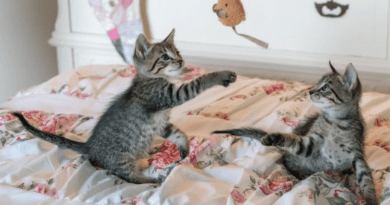Training Techniques
Training cats may seem challenging, but it is both achievable and rewarding. Unlike dogs, cats are less likely to follow commands naturally, but with the right techniques, you can teach them a variety of behaviors. This article delves into effective methods for training cats, focusing on introducing them to basic commands, leveraging positive reinforcement, and utilizing clicker training.
Introducing Your Cat to Basic Commands
Introducing basic commands to your cat involves patience and a structured approach. Cats have independent natures and shorter attention spans, so training sessions should be brief and engaging.
- Choose a Quiet and Comfortable Space: Begin training in a quiet room free from distractions. A comfortable environment helps your cat focus on the task at hand. Avoid noisy or busy areas that could divert their attention.
- Select Simple Commands: Start with straightforward commands like “sit,” “come,” or “high five.” These commands are easier for cats to grasp and can serve as a foundation for more complex training.
- Use Consistent Verbal and Visual Cues: Cats respond well to consistency. Use the same words and hand signals each time you issue a command. For example, when teaching “sit,” use the command “sit” consistently and pair it with a hand motion that indicates sitting down.
- Break Commands into Manageable Steps: Simplify the learning process by breaking commands into smaller steps. For instance, when teaching your cat to “sit,” you might first use a treat to lure them into a sitting position. Reward them immediately when they sit, then gradually reduce the need for treats as they learn the command.
- Keep Training Sessions Short: Cats generally have shorter attention spans compared to dogs. Limit training sessions to 5 to 10 minutes to keep your cat engaged. Conduct multiple short sessions throughout the day rather than a single long session to reinforce learning.
- Use Treats and Toys as Lures: To encourage your cat to perform a command, use treats or toys as lures. For example, hold a treat above your cat’s head to prompt them to sit. Once they follow the lure and sit, reward them promptly.
Using Positive Reinforcement Effectively
Positive reinforcement is a training technique that involves rewarding your cat for exhibiting desired behaviors. This method strengthens the likelihood of the behavior being repeated.
- Immediate Rewarding: Timing is crucial with positive reinforcement. Reward your cat immediately after they perform the desired behavior. This immediate reinforcement helps your cat make the connection between their action and the reward.
- High-Value Treats: Use treats that your cat finds highly appealing. High-value treats, such as small pieces of cooked chicken or special cat treats, can significantly increase motivation and improve training outcomes. Experiment with different treats to discover which ones your cat prefers.
- Praise and Affection: In addition to treats, verbal praise and physical affection are effective rewards. Speak in a soothing, enthusiastic tone and offer gentle petting. Cats often respond positively to a calm, affectionate approach.
- Avoid Negative Reinforcement: Negative reinforcement, such as punishment or scolding, can lead to stress and fear in cats. Instead of punishing unwanted behaviors, focus on redirecting them and reinforcing positive behaviors. For example, if your cat scratches furniture, redirect them to a scratching post and reward them for using it.
- Consistency is Key: Ensure that all family members are consistent with commands and rewards. Mixed signals can confuse your cat and hinder their learning process. Consistency in training helps your cat understand what is expected of them.
Clicker Training for Cats
Clicker training is an effective method that utilizes a distinct “click” sound to mark desired behaviors. This technique helps your cat understand which behaviors are being rewarded.
- Introducing the Clicker: Start by letting your cat become accustomed to the clicker sound. Click the device and immediately offer a treat. Repeat this process several times until your cat associates the click sound with receiving a reward. This step is crucial for building a positive association with the clicker.
- Marking the Behavior: Once your cat is familiar with the clicker, use it to mark the desired behavior. For example, if teaching your cat to “sit,” click the moment their bottom touches the ground and then give a treat. The click sound serves as a clear marker that their action was correct.
- Shaping Complex Behaviors: Clicker training can be used to shape more complex behaviors by breaking them down into smaller steps. For instance, if teaching your cat to “jump through a hoop,” start by rewarding them for touching the hoop with their nose. Gradually increase the difficulty by rewarding them for stepping through the hoop and eventually for jumping through it.
- Maintaining Consistency: Consistent use of the clicker is essential for effective training. Always click and reward immediately to reinforce the behavior. Regular practice helps solidify your cat’s learning and ensures they remain motivated.
- Gradual Fading of the Clicker: As your cat becomes more proficient with the command, you can gradually reduce the use of the clicker and rely more on verbal praise and treats. This transition helps your cat learn to respond to commands without the need for constant clicker use.
Training cats requires patience, consistency, and a positive approach. By introducing basic commands, using positive reinforcement effectively, and incorporating clicker training, you can teach your cat a range of behaviors and strengthen your bond with them. Remember to keep training sessions brief and enjoyable, and always reward your cat immediately for their efforts. With persistence and understanding, you can achieve successful training outcomes and foster a well-behaved, happy feline companion.




